The Science of What’s in Your Water, and Different Treatment Options
You know you should treat your water. You know there are bugs potentially floating in that water, but what exactly could be in there? When should you use a certain treatment over others? When every group of hikers around a fire includes someone insisting water treatment is unnecessary and synonymous with extra ounces, do you even need to treat your water?
What’s in That Water?
A whole host of different little microscopic buggers–bacteria, viruses, and parasites—can lead to disease. The vast majority of these disease-causing microbes (i.e., pathogens) that are carried in untreated water cause gastrointestinal upset (especially diarrhea), which can range from severe to mild. The dangers of becoming sick increase significantly when you’re far from help and could quickly become severely dehydrated and incapacitated, making it difficult or impossible to rescue yourself. There are many ways these pathogens are spread, but most of the bugs we’re worried about in water have a favorite: the fecal-oral route. Pathogens that infect animals via the fecal-oral route have to enter your mouth and gastrointestinal tract somehow in order to cause disease. You’re most likely to get sick from someone else’s dirty hiker hands contaminating a surface you touched or food you ate, contaminating your own hands with feces either directly or indirectly, or through contaminated water. Yes, you read that right: the most common source of water contamination is poo somehow getting in the water somewhere upstream from you, be it from another unwary hiker or a cute little critter.
Viruses
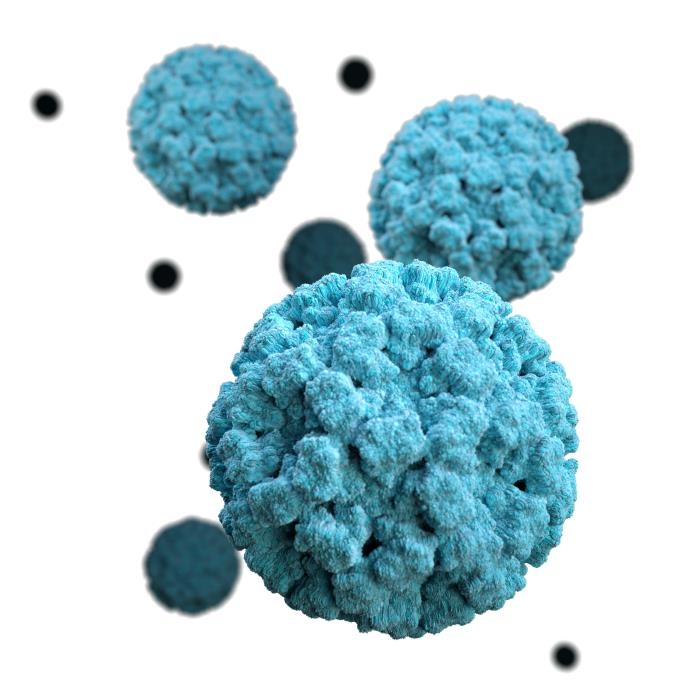
3D graphical representation of a number of norovirus virions. Image from Public Health Image Library (PHIL).
Viruses are clumps of DNA or RNA that hijack our own cells’ machinery in order to replicate themselves, and are not technically alive. The viruses you may be exposed to vary significantly across the globe, but adenoviruses, astroviruses, hepatitis A and E viruses, rotaviruses, caliciviruses (like norovirus), enteroviruses (like poliovirus), polyomaviruses, and cytomegalovirus are all possibly carried in water and shed by humans and other animals either in feces or urine. While almost all of these delightful little buggers cause diarrheal illnesses, some, like polio, can cause significantly worse illness.
In general, most of us are fortunate not to encounter backcountry situations where we are at a very high risk for viral contamination. Viruses are often species specific, which means the highest risk for viruses exists where human fecal contamination is more likely. Most of the popular long trails are fortunately relatively remote from concentrated human populations and agricultural operations, and within most developed countries the sewage systems are typically adequate to prevent widespread contamination. Unlike many bacteria and protozoa, viruses tend to be more fragile, which means that without continuous contamination from something like sewage runoff, those viruses are likely to die off quickly.
This isn’t to say you are immune in the backcountry, though: norovirus, or Norwalk virus, is a thru-hiker curse. While you’re far more likely to contract noro from another hiker’s unwashed fingers in your gorp, it is spread via the (lovely) fecal-oral route and can contaminate water sources.
Parasites

A scanning electron micrograph of the surface of the small intestine infested with Giardia sp. protozoa. Image from Public Health Image Library (PHIL).
Giardia is often mistaken for a bacterium, but is actually a protozoan parasite. Our little single-celled friend and its common protozoan cousin, cryptosporidium (crypto), are the most common culprits of waterborne disease both in the backcountry and in general. These parasites have life cycles that require an animal host and can be carried by livestock, wild animals, and birds, as well as humans, making them far more common in the environment. Studies have indicated that 97% of surface waters were contaminated with Giardia or crypto, meaning it’s not just water sources around beaver habitats that require careful treatment. Both of these common protozoans are released into the environment as a dormant, immature cyst with a tough outer shell, making them very resistant to the environment and allowing them to survive for months, even in cold water. You may never know when you were infected or the water source to blame, because it can take multiple weeks for symptoms to appear and as few as ten cysts can lead to infection. Notably, it is possible to become infected from dirty water, have an active infection, and not show symptoms while still shedding infective cysts into the environment and possibly infecting others.
There are other protozoan parasites of concern beyond Giardia and crypto, most of which are more common outside of North America. Amoebic dysentery, caused by Entamoeba histololytica, is very common in South America, Africa, and Asia. Though it is a less common route of infection, people can be infected by parasitic worms, including the liver fluke Faciola hepatica, by ingesting contaminated water. Some protozoans, like those that cause schistosomiasis and the famous brain-eating amoeba Naegleria fowleri, may also be present in water sources, although they lead to infection through the skin or water entering the nose, and not by drinking dirty water.
Bacteria

Cholera bacteria (Vibrio cholerae) (Sanofi Pasteur, Wikimedia Commons.)
If we consider the cells on and within our body, only about 10% of them are human cells and the rest are bacterial. Most of them are either harmless or actually provide benefits to us, like helping digest our food. Wild and domesticated animals that may live and potentially defecate upstream from water sources are often natural or asymptomatic carriers of certain bacteria, providing reservoirs for these pathogens, including well-known Escherichia coli and Salmonella strains. Unlike viruses, many bacteria have the ability to survive well in the environment.
The list of bacteria that can contaminate water sources is long, but there are some common names. Vibrio cholerae, the causative agent of cholera, is a famous example; the identification of water contaminated with cholera bacteria causing disease was one of the earliest examples of public health and the birth of the field of epidemiology. Salmonella, an enteric bacterium you’ve probably heard of, lives in the intestines of most animals. Most Salmonella strains only cause mild gastrointestinal illness, but the family also includes Salmonella typhi, the causative agent of typhoid fever. Campylobacter jejuni is one of the most common food and waterborne pathogens, and you’ve probably heard of Escherichia coli before. Most strains of E. coli are completely harmless, with many strains even being beneficial to our health, living in our intestines and helping us process food, or producing insulin in laboratories for diabetic patients. Of those strains that are pathogenic, most produce only mild illness. Some bacteria, however, like the ever-famous E. coli O157:H7 and strains of Shigella, can cause severe illness and even death by producing harmful toxins, including Shiga toxin. These toxins attack cells in the intestine, leading to bloody or watery diarrhea and a fever, and resulting in bacterial dysentery, in case you were hoping to re-enact the Oregon Trail video game IRL.
Other Contaminants

(Jamain, Wikimedia Commons)
There are, of course, other things beside pathogens in water that you might be concerned about. The risk of these contaminants is growing as agriculture and industry encroach on public lands and climate change alters habitats, but you’re still pretty unlikely to encounter these pollutants in any concerning concentration or without sufficient warning. Cyanobacteria blooms (i.e., blue-green algae) have become more common, and there is concern for more frequent blooms due to climate change. Cyanobacteria release a toxin into the water it grows in (cyanotoxin), which is what makes you or your pets sick if it is accidentally consumed. Agricultural and industrial run-off may contain harmful chemicals like fertilizer, pesticides, and runoff from mining. Some water sources may leach metals and other minerals from underground; this concern exists primarily with hot springs. Most of these contaminants significantly alter water color, smell, or taste when they are in concentrations high enough to make you sick. It should be noted that the tea-like coloring common in backcountry water sources is likely due to tannins from decaying foliage, and is safe to consume.
What Are Your Water Treatment Options?
Filtration
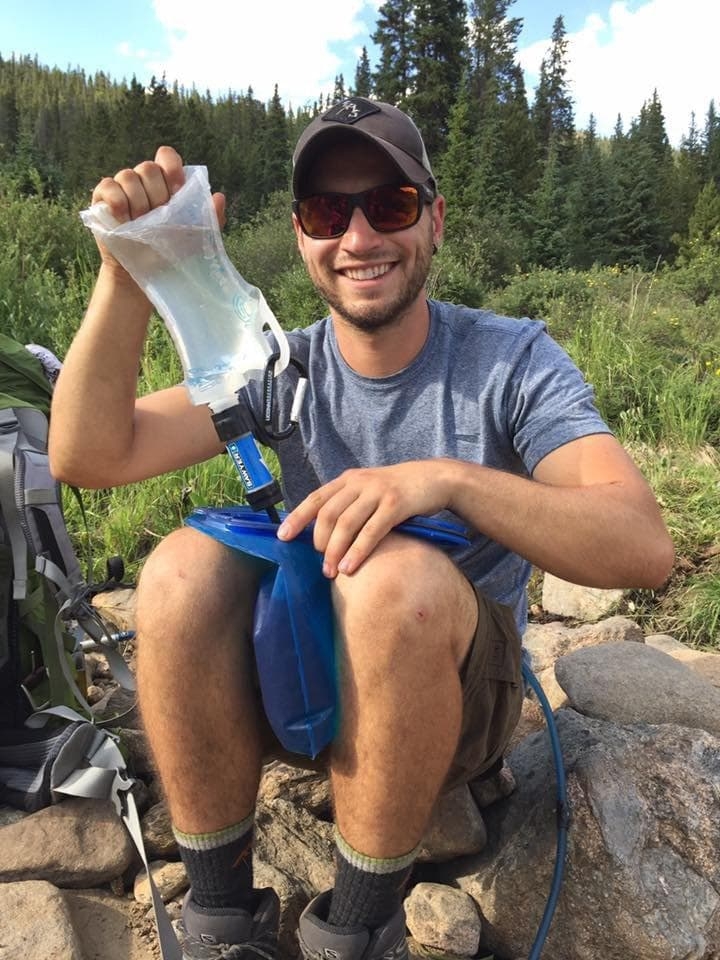
Photo courtesy of @eastcoasterica
Just like a coffee filter keeps those grounds in place while making your morning brew, a mesh of very tiny pores is inside your backcountry filter, preventing bacteria and protozoa from sneaking through into your bottle. Filters with pores small enough to remove microbes are measured in microns or micrometers (one millionth of a millimeter), sometimes written as “μm.” For functional purposes, there are no differences between squeeze, pump, and gravity style filters, and choosing between these styles is simply personal preference.
To give you a better understanding of how these filters work, let’s compare sizes (no, not like that). Protozoan parasites like Giardia are 2 – 6 microns, while most bacteria range from 0.2 – 2.0 microns (Campylobacter jejuni is only 0.2 microns wide). The best backcountry filters will have 0.1 micron pores (this information should be written on the packaging and in the online description), which will exclude all of those nasty bacteria and protozoa and provide impressive protection in locations where viruses are not a concern. 0.5 micron and 1.0 micron filters are still common. They’ll do the job against protozoa like Giardia and some concerning bacteria, but they’re not going to fully protect against the most common bacterial contaminants.
Your filter cannot do everything, however. It isn’t entirely true to say that viruses cannot be filtered, but the most common viruses range from 0.02 – 0.3 microns in size, which means the vast majority of them slip right through the pores of standard filters. Filters with pores small enough to remove viruses are often impractical in the backcountry, as it is difficult to push water through the small pores, especially if the total filter size is small to reduce carried weight, and they become clogged very easily with tiny pieces of debris. There are special filtration systems that use something called “electroabsorption” to trap viruses as well as other harmful pollutants, but they are still a novel technology and pose similar issues with durability and ease of use at this time. Your basic backcountry filter will also not remove chemical pollutants, including chemical runoff from agricultural systems or those chemicals that cause poor water taste, or toxins like the Shiga toxin produced by EHEC or Shigella bacteria.
Who among us hasn’t used a filter for over 2,000 miles, backflushed it maybe twice, and then proceeded to sling it into a dark box when the trip was over? Filters may seem nearly idiot proof, but they are subject to failure if they are treated poorly. There are two main things you should be concerned about with your filter. If you push debris through, especially if done forcefully, it can rip the many tiny fibers inside that compose the filter and cause the pores to enlarge. Remember, this applies both to debris in the water your filtering and debris that may have built up on the filter over time. It is also possible for trapped bacteria to grow inside the filter and inundate it, forcing pores open as they grow and compromising the filter. Pre-filtering, with a bandana for example, can reduce the risk that debris will damage your filter, and regular backflushing can remove built-up debris inside the filter. Especially before your filter is about to sit forlornly in your gear storage, it is a good idea to sanitize it to kill any bacteria that might be present, which will prevent bacterial overgrowth and help kill anything that may have contaminated the clean water side accidentally. It is always best to follow manufacturer’s instructions; Sawyer recommends sanitizing your filter with a bleach (sodium hypochlorite) solution. Bonus: All of these actions will also prolong the life of your filter. Dropping or otherwise subjecting your filter to blunt trauma and freezing it are also possible causes of damage, though obviously much harder to fix. If you suspect your filter has been damaged, replace it.
Chemical Treatment

Photo courtesy of @eastcoasterica
If you’ve spent any time at all in the backcountry, you’re probably familiar with chemical treatment like Aquamira. There are a few different options available to hikers, with some important differences. Chemical treatments applied correctly will kill protozoa, bacteria, and viruses in a light, simple, cheap package, and are available commercially or can be made at home.
There are some downsides to chemical treatment, however. You are limited to the amount of product you have with you—if it runs out, or you spill it, you may be SOL. Many of the chemicals will react with the air once opened and need to be thrown away after a period of time as they will become ineffective—always label your chemical of choice clearly with the date of first use. Silt, leaves, and other detritus in water can be gross to drink, but even in small amounts it also provides a nice little hiding spot for microbes, which means dirty water may not be effectively purified by chemical treatments as they are typically applied, making pre-filtering very important. Chemical treatments also have a fairly long wait time, often 30 or more minutes before water can be safely used, which can be frustrating when you’ve been out of water for the past five miles in draining heat and humidity and you just want a fricking drink. These chemicals take longer to react in cold water, which can increase this wait time, even causing it to double. Contact time is an often overlooked but rather major component of chemical treatments. Most chemical treatments are “oxidants,” which work by eating away the cell wall of cells or disrupting their metabolism, like affecting their DNA or their ability to move nutrients across their membrane. These treatments work by breaking down the bodies of microbes, meaning they need enough time to do their job, especially on those tougher bugs with tougher shells.
Iodine
Iodine is an effective chemical treatment, but is a less popular option, as many people dislike using it due to its taste. Unfortunately, cryptosporidium oocysts are highly resistant to iodine, even with prolonged contact time and you should not consider it an effective treatment against crypto. Iodine in liquid and tablet form is light sensitive and will degrade when exposed to light, so don’t swap your tablets into a clear plastic baggie, and try to reduce how long the lid is open.
Chlorine
While chlorine also adds a flavor to water, it is much more familiar with the ubiquity of chlorine and chloramine in the treatment of household water, and therefore less off-putting. Because elemental chlorine is highly reactive, it is far more stable when “bundled” in a compound, and there are actually a few different compounds that contain chlorine that are useful for water treatment. Halazone is an older treatment that has lost popularity, and sodium dichlorisocyanurate is a very popular disinfectant worldwide, though less common in backpacking setups. Chlorine dioxide (ClO2) is a popular chemical treatment option and is readily available at outdoor retailers; it is one of the most effective forms of chlorine for disinfection. Sodium hypochlorite (NaOCl) or calcium hypochlorite (CaOCl) are the chlorine compounds most commonly present in household bleach, which means this is the compound you will be using if you make a DIY water treatment from household bleach. Be careful to inspect the label on the bottle to confirm it contains one of the above compounds, and double check the concentration on the bottle as it varies. Unfortunately, Giardia can be and crypto is also resistant to chlorine, especially in colder water.
Silver ions
Silver ions are a newer tool in our backpacker’s chemical toolbelt, but have proven effective across the range of pathogens we have discussed, including both Giardia and crypto. Silver itself has a long history of antibacterial properties and uses across health and medicine (basically, pathogens are also werewolves). Some people may have concerns about the possible long term health effects of silver, but these risks are likely mitigated by the relatively infrequent use of silver ions by backpackers.
Boiling

(Michael Pereckas, Wikimedia Commons).
Boiling kills viruses, parasites, and bacteria, which is pretty great. It will even deactivate toxins produced by bacteria that escape other forms of treatment. It’s basically a one-stop shop for water treatment. While most of us know that boiling our water is an effective way to treat it, many don’t know that water needs to be kept at a roiling boil for at least 60 seconds before it is safe to consume. Those of you waiting for the first sign of bubbles to drop in your Idahoans could be putting yourself at risk. If you’ve ever boiled water to treat it before, you’ll know those are a long 60 seconds; I highly recommend setting a timer.
The biggest downsides to boiling is that it requires you to carry a stove. Some backpackers might be limited by the volume of their pot, which can become time-consuming, and of course the water has to be cooled before it is drinkable or can be transferred into a plastic water bottle. Boiling will also not remove any chemical contaminants, and can actually make them more concentrated in your water because some of the water evaporates, but the chemicals stay behind.
UV Treatment
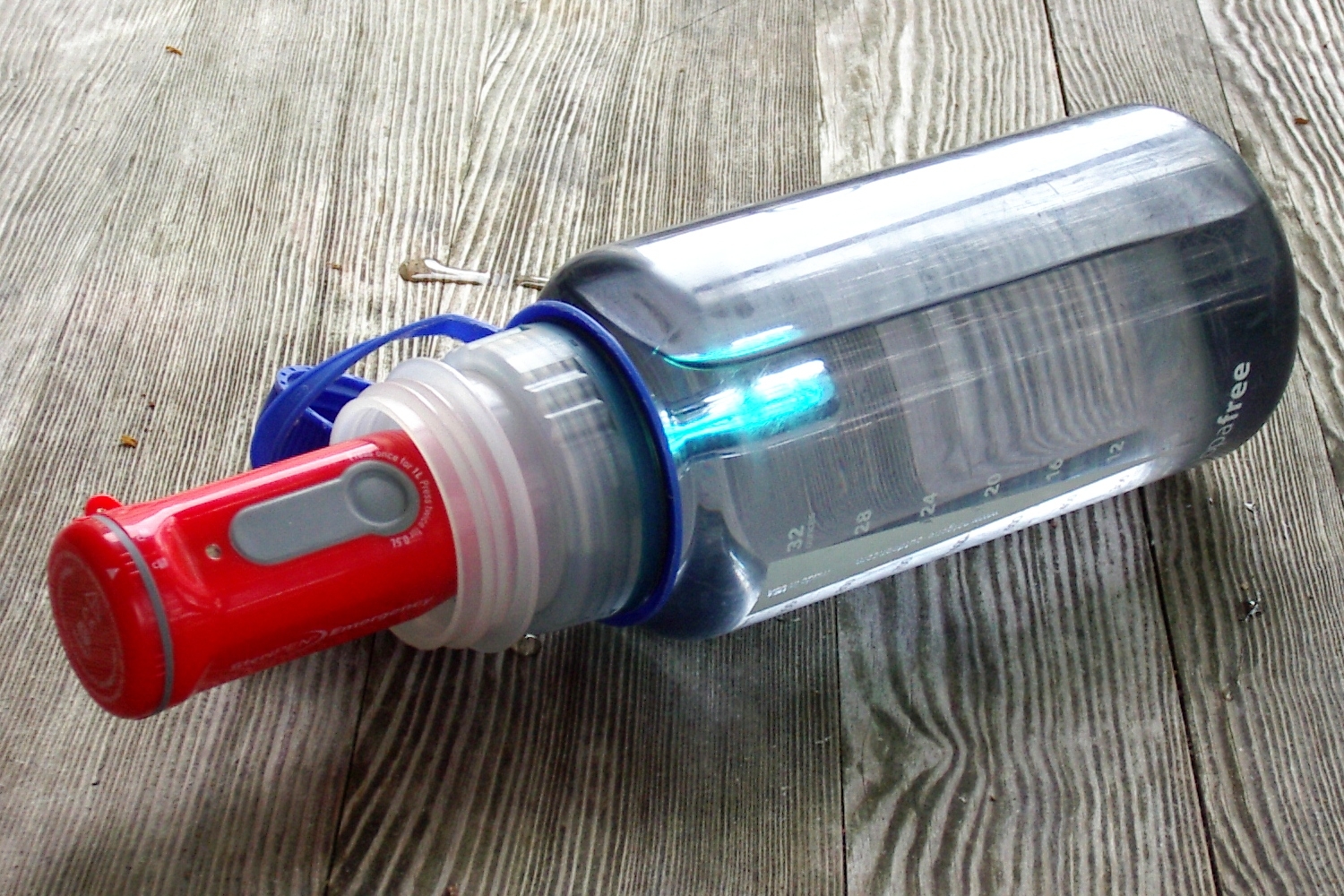
(Coronium, Wikimedia Commons)
While some of the wavelengths given off by a UV bulb appear purple, ultraviolet light itself is a wavelength of light that is invisible to the human eye, and can be an effective microbe killer. It works by penetrating into cells and scrambling their DNA— just like UV rays from the sun increase our risk of skin cancer because they damage our own cell’s DNA and, if the wrong sections of DNA are damaged, leads to abnormal cellular replication. UV can unfortunately be very finicky and inefficient in practice.
Just like chemical treatments, it is super important that you follow the directions with ultraviolet light. The tiny lamps used in backcountry apparatuses are small and sufficient UV light for microbe murder only extends so far from the lamp. UV lamp manufacturers provide specifications for the containers that you can treat in, and this should be followed nearly exactly. If, for example, you use a very tall bottle, it is possible that only the top of the bottle will be sufficiently treated and the water near the bottom will remain a happy little home for your waterborne germs. Further, particulates in the water, cloudiness, or color that even a pre-filter might not be able to remove such as tannins, will significantly affect the viability of the UV purifier. UV is much quicker than chemical treatments, but contact time is still very important. Most devices on the market have built in timers for their cycles, and many specify the need for multiple cycles for larger volumes of water.
Anecdotally, I’ve encountered more than a few hikers who were pretty squicked out by the reality of UV treatments: the pathogens in your water might have had their DNA scrambled so that they cannot reproduce and cause infection, but many are still alive for all intents and purposes and their microscopic bodies are still floating around in your drinking water. If that idea bugs you (pun intended), this might not be the treatment option for you. UV systems also face issues with battery life (especially in cold weather), the need to carry around extra batteries in general, and durability, which should be considered when purchasing a system.
Carbon Filters
None of the above methods can remove chemical contaminants, however. Carbon works by a process known as adsorption, which is basically fancy speak for drawing in and trapping chemicals in large pores in its structure. Carbon filters are fairly uncommon in the backcountry, as chemical pollutants are still a low risk for backpackers and of minimal concern, and our bodies are pretty impressive at processing low concentrations of many, many harmful substances. The EPA, FDA, and other regulating organizations have certain thresholds for pollutants that they consider concerning and it is only above these levels that physical harm is likely to occur. An activated carbon filter is especially effective against things like chlorine, pesticides, and certain fertilizers, but it will not remove all chemicals (harmful minerals and salts, for example) and is not effective against pathogens. Again, it is important that you do your due diligence to determine if it will remove the pollutants of concern in the area you will be treating water from. It should also be noted that carbon filters have short lives as the carbon must be active in order to bind to the chemicals you may be concerned about; these filters should be replaced within six months of being activated by their first use.
What Should You Consider Before Picking a Water Treatment?

Photo courtesy of @jaysonthetrail
The two biggest questions when picking a form of water treatment are “what are the risks in the area I’m going to” and “what is the level of risk I’m personally comfortable with?” The ideal water treatment is twofold, using filtration first to remove particulates and large pathogens from your water, and then either chemicals, UV, or boiling to treat anything left behind after filtration. Many people consider this overkill, however, including in the North American backcountry, where concern for viruses is very low and trumped quickly by convenience and weight savings.
In almost all instances, I would recommend a treatment that will handle protozoan parasites (Giardia, in particular) given just how ubiquitous they are in the backcountry. If you are traveling somewhere where human or animal waste runoff is more likely, a treatment that will be effective against viruses is definitely a good idea. This is especially true if you’re traveling to countries that already have warnings about their water; if you’re urged to drink bottled water only, for example, there is a strong concern for viral contamination. Additionally, some people are more at risk for waterborne illnesses than others and may warrant a more aggressive approach to water treatment. If you or someone in your group is immunocompromised in any way, a young child, or elderly, they may become sick easier, and may have more harmful complications from these aquatic germs than the average, healthy young adult.
Ultimately, water treatment is a very personal preference. Within the categories above, there are multiple products that function a bit differently, are more or less hardy, and may just be more attractive than another to carry for one reason or another. In the end, be safe, be smart, and spend some time doing your research.
Further Resources:
Marshall, M. M., Naumovitz, D., Ortega, Y. & Sterling, C. R. Waterborne protozoan pathogens. Clin Microbiol Rev 10, 67–85 (1997).
Badar, M., Khokhar, I., Batool, F., Iqbal, R. & Ch, Y. Effect of boiling on removing of shiga toxins from drinking water samples. in (2017).
Giardia: Drinking Water Fact Sheet | EPA
Photoreactivation – an overview | ScienceDirect Topics.
Jarroll, E. L., Bingham, A. K. & Meyer, E. A. Effect of chlorine on Giardia lamblia cyst viability. Appl. Environ. Microbiol. 41, 483–487 (1981).
Shin, G.-A. & Sobsey, M. D. Inactivation of norovirus by chlorine disinfection of water. Water Res. 42, 4562–4568 (2008).
Guide to Water Purification | Outdoor Action
Rasooly, R. & Do, P. M. Shiga toxin Stx2 is heat-stable and not inactivated by pasteurization. Int. J. Food Microbiol. 136, 290–294 (2010).
CDC. E. coli and Food Safety. Centers for Disease Control and Prevention (2019).
Campylobacter (Campylobacteriosis) | Campylobacter | CDC (2019).
Boil Water Response – Information for the Public Health Professional
Bad Backcountry Water: Giardia, Crypto, Bacteria, Viruses
Rusiñol, G. Summary of Excreted and Waterborne Viruses. Global Water Pathogen Project (2015).
Giardia infection (giardiasis) – Symptoms and causes. Mayo Clinic
Gall, A. M., Mariñas, B. J., Lu, Y. & Shisler, J. L. Waterborne Viruses: A Barrier to Safe Drinking Water. PLoS Pathog 11, (2015).
This website contains affiliate links, which means The Trek may receive a percentage of any product or service you purchase using the links in the articles or advertisements. The buyer pays the same price as they would otherwise, and your purchase helps to support The Trek's ongoing goal to serve you quality backpacking advice and information. Thanks for your support!
To learn more, please visit the About This Site page.

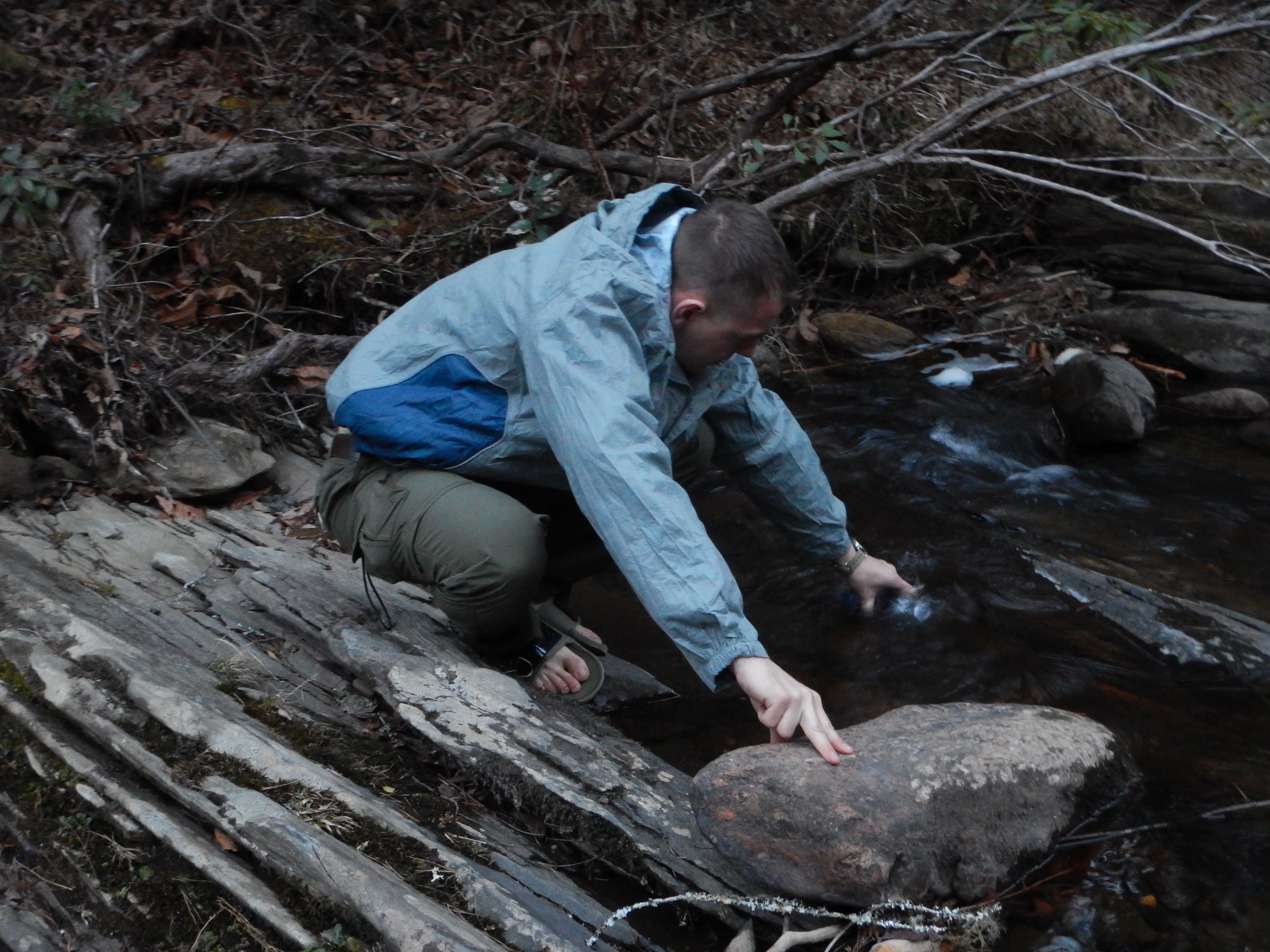
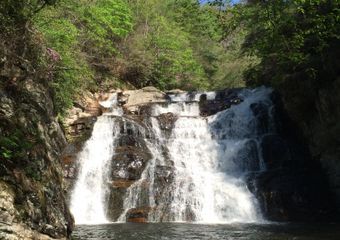
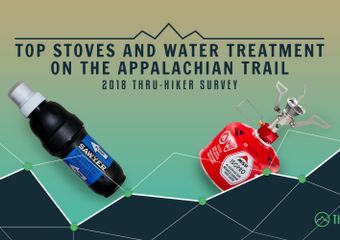

Comments 7
Well-written and so informative!
Tasia, thanks for that well written article. I believe that you covered all the bases and the risks that you might accept. After trekking in Nepal for several weeks, I was “fortunate” to have returned to Katmandu before the bottom fell out. Still don’t know what I picked up, but I don’t wish that on anyone. Back then, iodine was pretty much the option, along with boiling. It’s great to see many more options available to today’s backpackers.
Incrediably useful. Thank you!
Thank you for this article.
Clearly written, informative — this is the best piece on filtering I’ve ever read.
Well done!
Great article, very comprehensive. I think it should be emphasized that regardless of the method chosen, it’s important to manage the “dirty” and “clean” side of your system effectively. It doesn’t do any good to filter the water then contaminate the product of all your work by accidentally dripping untreated water into your drinking container. This can occur when you dip you collecting device (cup, bottle, squeeze bag, etc) into the stream and drops run down it into the clean water, or from your hands. Unwashed hands are also a common “fecal-oral” route. Not every hiker is good at keeping their hands clean, so be thoughtful when sharing food or touching (fist bumps are good). All that said, except in a few notable cases, a pretty small percentage of hikers get sick–some part of which can be credited to water sources that are actually pretty clean…most of the time.